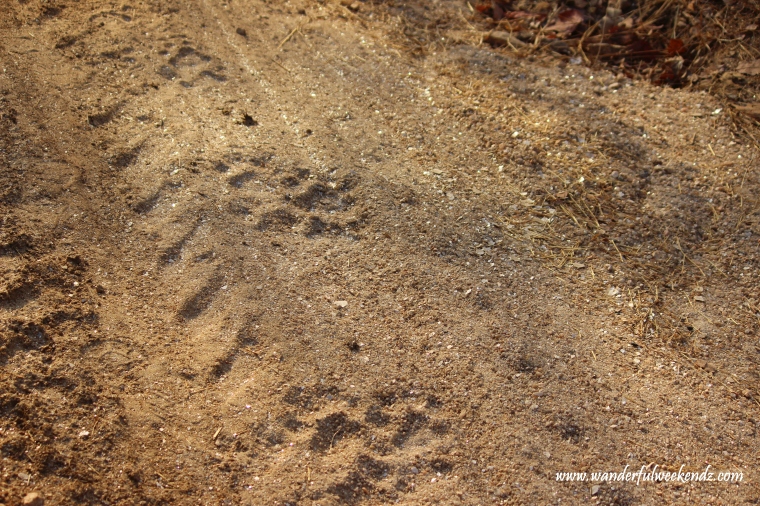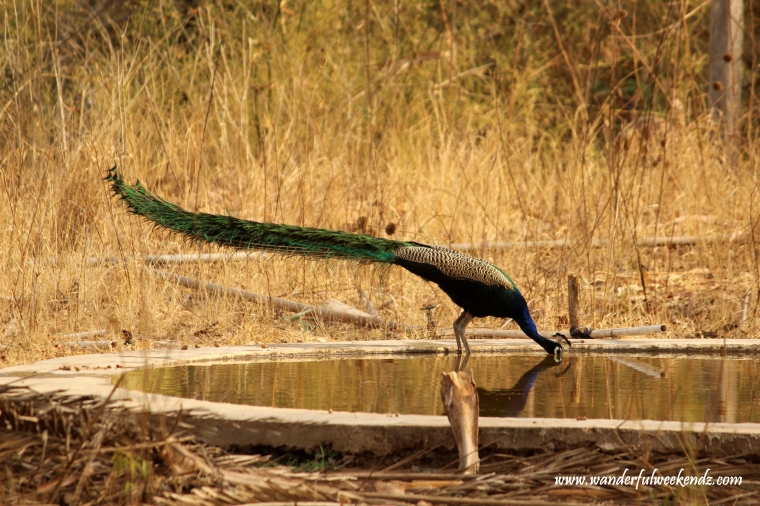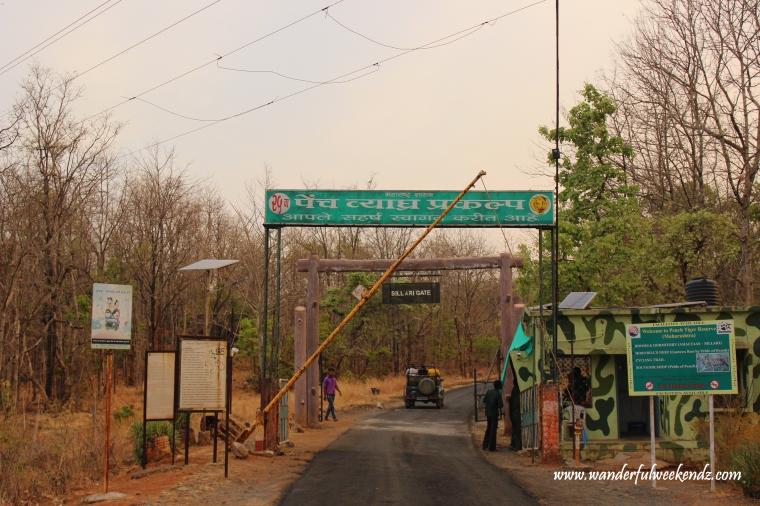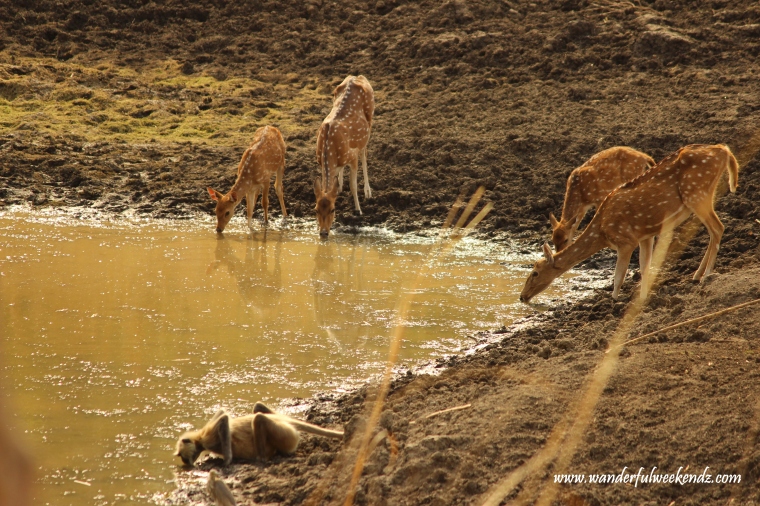It’s been four months since our trip to Pench Tiger Reserve but even now when I think about the trip, I can vividly remember the hour and half we spent sitting in silence in the open canter parked at a respectful distance from that watering hole in the jungle where the big cat was seen the previous morning. Before we set out on the safari, our guide Babru had told us, spotting a tiger in the jungle needs as much luck as planning. The harsh May sun burnt against our skin and every passing minute weighed heavy with anticipation as the calls of the langurs and the birds perched high in the trees grew intense, faded away and then grew intense again signaling that a striped one hidden behind the tall dry yellow grass was on the move.

It was a duel of perseverance between our resolve of a tiger sighting and the tiger’s yearning for a drink of the cool water on a hot hot summer day. Both of us held fast to our positions but in the end our time ran out against the tiger’s patience. And in spite of Babru’s fool proof planning, we had to retreat to the gate of the park as the safari’s time was over.

Straddling the border of the states of Maharashtra and Madhya Pradesh, the Pench Tiger Reserve derives it’s name from the river of same name that cuts it into two equal halves. Pench was also the inspiration for Rudyard Kipling’s ever popular children’s novel, The Jungle Book. It is believed the Kipling’s 1894 book was inspired from a 1831 pamphlet ‘An Account of Wolves Nurturing Children in Their Dens’ which describes a wolf-boy captured in the forest of Seoni (which is now Pench Tiger Reserve). Check here for more on that.
I won’t deny that having grown up watching Mowgli’s exploits on TV every Sunday morning, it was as much the thrill of spotting a tiger in the wild as the excitement of visiting Kipling’s inspiration for the novel that drew us to Pench. And although the former wish was not full filled, we were lucky to spot a wide variety of other wild animals and birds including spotted deer, sambhar deer, nilgai, gaur and wild boar. True to it’s reputation, the watering hole was were the most action was!







The forest itself was charming changing it’s form every few kilometers. As we drove further inside, the forest cover changed dramatically from haphazard jumble of grey green to skeletal tree trunks jutting out of the crinkly blanket of dry yellow fallen leaves to gentle grasslands. Beyond the grasslands, the dwindling river had carved concentric patterns on the banks leaving behind huge sea shell shaped dunes. It was not difficult to imagine Mowgli, Balu and Bagira prancing around and swinging from the wines of this woodland or diving head first into the stream.

When to Go:
The best time to visit are the summer months from April to June. The forest cover is scanty making it easier for the naked eye to see further into the jungle. The scarcity of water also makes it imperative for animals to roam about far and wide making sightings more frequent. Winter is also a pleasant time to visit. However, monsoons are to be avoided as the tiger reserve remains closed during the monsoons that last from July to mid October.

Although visitors are not allowed inside the forest after sunset, the Machaan Survey held on full moon night in mid May is a good opportunity to experience the forest and surroundings in the dead of the night. Booking can be made online on the Maha Eco Tourism site given below but spending a night alone on a rudimentary tree house (the machaan) with wild carnivorous animals on prowl just a couple of feet below is certainly not for the fainthearted.
Getting there and around:

The National Park is accessible from both Maharashtra as well as Madhya Pradesh. Although there are a number of entry points, on the Maharashtra side Sillari is the most popular and on the Madhya Pradesh side, Turia, Karmajhiri and Jamtara are more popular. While the Madhya Pradesh side is reputed to have more tiger sightings than the Maharashtra side, going for multiple safaris is probably the only way to improve one’s chances of spotting the elusive creature. We went on two safaris, one in the morning other in the evening but some of the other visitors we met had been on four to six safaris on this trip alone.
The closest airport and railway station is Nagpur. Cabs are easily available from Nagpur to all of the entry gates.
Safari slots open for booking 120 days in advance and are sold out months in advance hence, check online before planning the trip. For safari booking on Maharashtra side check here and for Madhya Pradesh check here.

Where to Stay:
There are number of private resorts in Sillari and Turia but for budget stays check out Maharashtra Forest Department’s guest houses at Sillari Gate. The Sillari safaris start from inside the complex so that is a definite advantage. The eco-huts here are clean but not luxurious. There is no air conditioning but just a plain desert cooler so the asbestos roofed huts can get pretty stuffy from inside in summers. The complex has a canteen with uniformed waiters and serves pretty decent Indian food. Being inside the forest, there are pretty much no other eating options around and expect the mobile network to be patchy as well. The MTDC resort about half a kilometer ahead is marginally more luxurious with air conditioning and a swimming pool.
On the Madhya Pradesh side too, the forest department provides accommodation. Click here for booking details.
Happy Exploring!!!

For more weekend destinations off the beaten track, follow us on:


The Peacock pic is so awesome. No tiger but good wildlife photography !!! Keep it up.
LikeLiked by 1 person
Thank you. 🙂
LikeLike
awesome pics aussie!!
LikeLiked by 1 person
Thanks you Banni!
LikeLike
Love the post and the photography 🙂
LikeLiked by 1 person
Thank you. Glad that you enjoyed reading it.
LikeLiked by 1 person